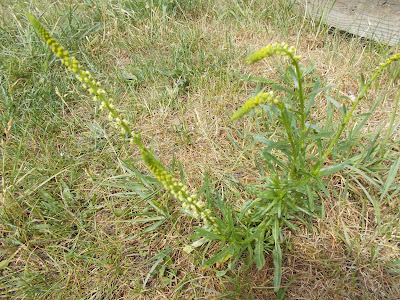I parked up beside Daventry's waste and recycling depot and, on stepping out from the car, almost trod on a plant of Weld, Reseda luteola. Now I do not claim that this is a rare or exciting species, but it is interesting.
 |
Dyers Rocket is frequent on dry stony ground. Here at Brown's Road,
Daventry. 16 June, 2020
|
The plant was rather small and should put on a good deal more growth over the next few weeks by when it is likely have developed an impressively long raceme of tiny flowers (if the council will hold back on its ruthless mowing regime). Four species of Reseda occur in Britain but only two are native (the other being Reseda luteola).
The other name for Weld is Dyer's Rocket and it has been used for the production of a dye since Neolithic times so its current distribution is in part due to its cultivation for this purpose. The dye yielded is generally yellow but in Lincolnshire it was used in the production of a paint called Dutch Pink. When John Clare mentions Woad there are reasons to believe that he really meant Weld.
It is typically found on dry, stony ground and in Northamptonshire it is most frequent in the far east of the county, but it also grows very commonly around Boddington Reservoir, in the far west. The name mignonette derived from the French mignon, meaning 'small and sweet' (or even 'little darling') and perhaps refers to the beautifully fragrant flowers of Reseda odorata. The word reseda is based on the Latin resedare - 'to assuage', because the plant was believed to be helpful in the treatment of aches and pains.
The other name for Weld is Dyer's Rocket and it has been used for the production of a dye since Neolithic times so its current distribution is in part due to its cultivation for this purpose. The dye yielded is generally yellow but in Lincolnshire it was used in the production of a paint called Dutch Pink. When John Clare mentions Woad there are reasons to believe that he really meant Weld.
 |
| The tiny flowers are frequently visited by bees. |
It is typically found on dry, stony ground and in Northamptonshire it is most frequent in the far east of the county, but it also grows very commonly around Boddington Reservoir, in the far west. The name mignonette derived from the French mignon, meaning 'small and sweet' (or even 'little darling') and perhaps refers to the beautifully fragrant flowers of Reseda odorata. The word reseda is based on the Latin resedare - 'to assuage', because the plant was believed to be helpful in the treatment of aches and pains.
A few yards further on grew several plants of Common Mallow, Malva sylvestris. The Malvaceae Family, to which it belongs, has received a lot of reorganisation in recent years but fortunately Common Mallow has come through unscathed. It too is frequent on open waste ground, so that although sylvestris means 'of woods or forests' I have never found it in such a situation.
 |
Common Mallow will attain a height of a metre or so but here it was hugging
the ground. Brown's Road, Daventry. 16 June, 2020
|
Some interesting beetles are found on mallow and I was pleased to record the tiny weevil Aspidapion aeneum.
 |
Aspidapion aeneum is frequent on mallows. Measurements in millimetres.
My specimens were only 3 mm in length.
|
The mallow yields a mucilage once much valued as a 'pectoral', that is, a remedy used in the treatment of chest problems such as dry coughs. In fact the original meaning of 'malva', as used by Pliny, means 'soft'.
One old country name for mallow was 'cheesecakes', the term referring to the flat fruits. Naturally John Clare had something to say on the issue:
The sitting down when school was o'er
Upon the threshold of the door
Picking from Mallows, sport to please
Each crumpled seed he called a cheese.
Clare's Shepherd's Calendar 1827
A white form was recorded from 'Thrapstone' (now Thrapston) in 1640 and is referred to in John Parkinson's Theatrum Botanicum.
As for what I found when I finally reached Kentle Wood - perhaps another time...
No comments:
Post a Comment